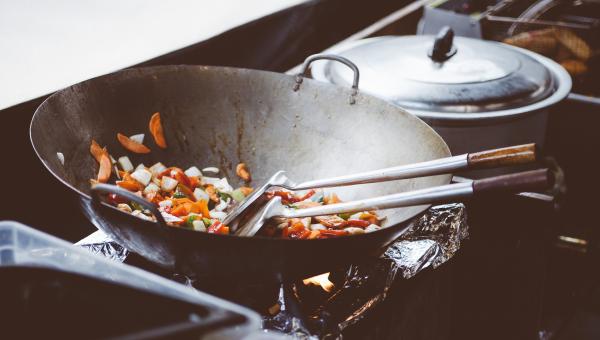Quick fun facts on salt and hypertension to provide a little context. In the US, we consume about 3.4 g of salt daily in our foods, and roughly 47% of us have hypertension. In China, the average dietary consumption of salt is 10 g and the prevalence of hypertension is anywhere from 18-44%, based on the study you are reading.
“…people living in different regions consume diets differently with different cuisines that bear strong local characters. “One size fits all” may not work in this situation…”
The study was prompted by the changing Chinese diet, with fewer grains, legumes, vegetables, and fruit and more meat, eggs, and oils. [1] And inspired by the DASH (Dietary Approach to Stop Hypertension) diet promoting “food as medicine.” The study, reported in Circulation, involved 255 participants with mild hypertension. Given China's size and various cultures, the participants were categorized as eating one of four major cuisines [2] and provided with either a control diet or a diet with reduced salt for 28 days.
Participants underwent a 7-day introductory period when their food likes and dislikes were identified so their test diets, whether control or the reduced salt Chinese Heart Healthy Diet (CHH), would be enjoyable. A catering service prepared all meals, and the participants were asked to eat in a common area (although they could take food home) during the 28-day study. Participants were provided with three meals a day without instructions concerning their physical activity. Participants were blinded as to whether they were in the control or experimental group, and the two groups were asked to eat separately. Participants who ate more than 80% of the meals were the basis for the dataset.
The CHH differs from the usual urban Chinese diet with reduced energy from fats and more energy from protein and carbohydrates. There is more dietary fiber and a doubling of potassium, offsetting the 50% reduction in sodium.
The study was terminated early because of concerns around COVID, so it was not as statistically “powered” as they had planned. But 97% of participants completed the 28-day study and consumed 97% of the meals.
 Both groups showed a reduction in blood pressure.
Both groups showed a reduction in blood pressure.- The CHH group reduced their systolic blood pressure (the upper number) by 10mm Hg more than the control group.
- The CHH group reduced their diastolic blood pressure (the lower number) by 3.8mm Hg more than the control group.
- Female participants experienced a more significant decline in systolic blood pressure than men
- The CHH group experienced a weight loss of about 1 pound, the control group a few ounces
The researchers also attempted to calculate the cost differential between the diets. In US dollars, the control diet’s food cost was $3.13, and for the CHH diet, $3.58. Based on those numbers, the researchers calculated that the cost of reducing blood pressure by 1mm Hg was 6¢. Of course, that doesn’t include the cost of preparing the meals, which the researchers felt was equivalent between the two groups; that said, that 6¢ number is a low estimate. For comparison, the daily cost of meals in the US is roughly $11.00
What might we conclude?
Even for a relatively short time, that diet reduced blood pressure. But did it lessen the need for medications? Individuals who changed their medications during the study were excluded, so we don’t know. And you have to admire the rigorous way the researchers went about the study, tailoring the diet to the participant's likes and dislikes, and “the involvement of master chefs during its development guaranteed the flavor of dishes through professional cooking to meet the CHH diet targets without sacrificing food flavor.” Having someone else providing you with professionally made meals three times a day is not a real-world scenario. (I suppose with the rise in meal-kit meals, this is no longer entirely true, but their cost would be in the range of $15 to $27 daily)
“…unlike the DASH trial, our study could not separate the effect of reducing sodium intake from those caused by changes in diet by design.”
That caveat at the end of the discussion does put a bit of a dent in the belief that reduced dietary sodium is the key to lowering blood pressure. And it is essential to note that the Chinese seem to have a different physiologic response to sodium. The sodium levels in this study that reduced blood pressure are comparable to the upper end of the American diet, where physicians ask us to reduce our salt intake by half once again to improve our blood pressure.
The Chinese eat more salt than any other group; their diet has more salt than any other country. One has to consider that cultural “choices” like diet are entangled and evolve with our underlying metabolism. And while I continue to believe that salt has a Goldilocks value, not too high or too low, this study made me wonder about salt intake in the regional cuisines of the US. While I look into our regional differences, I will leave my salt metabolism up to my kidneys which have been adjusting salt levels and blood pressure for thousands of years.
[1] It is interesting to conjecture that the change in diet is related to the rise of China’s middle class from roughly 3% of the population in 2000 to over 50% in 2018
[2] Shangdong, Huaiyang, Cantonese, Szechuan
Source: Effects of Cuisine-Based Chinese Heart-Healthy Diet in Lowering Blood Pressure Among Adults in China: Multicenter, Single-Blind, Randomized, Parallel Controlled Feeding Trial Circulation DOI: 10.1161/CIRCULATIONAHA.122.059045




